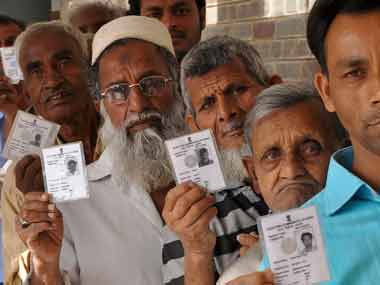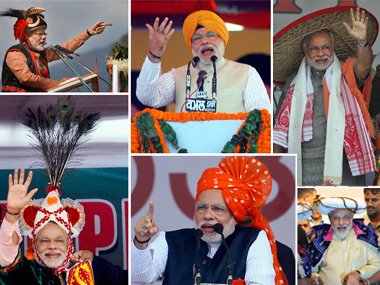Has the Election Commission, by holding a needlessly prolonged multi-phase poll, changed the nature of the electoral game forever? I believe so. Unless it changes tack in future, all parties will game the system, as I pointed out some time ago (read here ). It may also give us perverse results that the voter never originally intended. The most fundamental change is the result of the Commission’s decision to hold polls even in adjoining constituencies over several phases. If Uttar Pradesh started polling on 10 April and the process will end only a month later after six rounds on 12 May, it means on an average only 12-14 seats are being polled at a time. This has profound implications for the fairness of the electoral outcomes. For example, parties can now micro-cast different messages for different constituencies and change colours more frequently than a chameleon. A party can thus choose a development theme in phase one, a caste theme in phase two, a communal theme in phase three, and then flip back and forth till it achieves its fundamental purpose of being all things to all people. [caption id=“attachment_1511993” align=“alignleft” width=“380”]  The many avatars of Modi on display this election[/caption] It used to be said that national elections were nothing more than a bunch of regional elections aggregated together. Now, the Election Commission has ensured that national elections are hyper-regional where the central messaging by any national party or policy coherence is peripheral to electoral outcomes. Of course, parties have manifestos and broad perceptions guiding voters, but these serve more as a backdrop. They aren’t the main course served in constituencies. This loophole was first spotted by the late YS Rajasekhara Reddy in 2009, where in the first phase of Andhra polling he pretended to be pro-Telangana and in the next he went virulently against the idea – and won both regions. This time, nobody has been better able to use this opportunity to micro-cast messages than Narendra Modi, whose campaign has depended on sending tailored messages for each region, complete with a personal appeal. In Amethi, he could be the development messiah picking holes – and potholes - in the Rahul Gandhi story. In Faizabad, he can make subtle references to Ram Rajya, and in West Bengal he can talk of favouring refugees with Durgoshtami in their hearts. Most important, since the prime message is Modi himself, and his personal promise of development and governance, he can effectively make himself the virtual candidate in almost all constituencies. Thus, an Ananth Kumar in Bangalore South can parry a Nandan Nilekani’s effort to corner him on local issues by pointing out that people are voting for Modi, and not just him. Modi himself, by his indefatigable efforts, has addressed around 400 rallies – probably more, if you count the rallies held before the election dates were in sight. This means candidate Modi has effectively appealed to all constituencies directly. Three conclusions emerge from this: One, parties can now take completely contradictory positions in two different phases of the polls – as YSR demonstrated in 2009. They can thus have two agendas – a national one and a hyper-local one. This is clearly happening in UP and Bihar this time, not to speak of West Bengal. Two, parties can use their key campaigners more effectively. If Modi is the vote winner and not the local candidate, Modi can turn up in every constituency and say, “vote for me” even if he is not the candidate. In assembly elections, this can help a party with a star campaigner over-ride the consequences of bad local candidates. Three, voting trends in earlier phases can impact voter behaviour in later phases. This is not necessarily a benefit to one party, but all parties – since tactical voting and alliances can be changed (effectively, not literally) to ensure consolidation for or against specific candidates. If Bihar is swinging towards the Congress-RJD combine after it earlier seemed to be heading towards the BJP-LJP alliance, it is because the fear that the BJP may have gained ground has ensured tactical voting in later phases by Muslims. Put another way, it means basic voter intent is now becoming opportunistic and hugely tactical. One can argue about whether this is good or bad for democracy, but if one believes that allowing parties to be different things to different people is a travesty, then it does not make sense to have polling extending to one-and-a-half-months. Also, by enabling the results of earlier phases to impact voter intentions in later phases – especially when we are talking about the same state – this will mean voter intent can keep changing throughout the period of polling. A voter who intended to vote one way will end up voting another way after hearing what happened earlier. An undecided voter can decide to vote for a presumed winner in the earlier phase. It is almost a negation of the secret ballot system – since private exit polls and news reports can tell the voter what happened before and may influence her behaviour when her turn comes. If the BJP was the party to first take advantage of this multi-phase polling, the other parties are now joining in. Media interviews, tactical interventions (like Mayawati surfacing yesterday - 6 May - to ask about Modi’s caste) are becoming the norm. Apart from this, election 2014 has been different from earlier ones in many other ways, thanks to the importance of 24x7 media and digital platforms. Consider the differences. - What could have been a “normal” election was made non-normal by the personality involved and his effective use of media. Most other turning point elections characterised by “waves” - 1971, 1977, 1984, 1991 and even 1999 - were preceded by a big event like war or assassination. The exception was 1977, when it was preceded by Indira Gandhi’s emergency. 2014 is happening against a ‘normal’ backdrop. Beyond an economic slowdown one can hardly call 2014 an abnormal time needing drastic electoral swings. The obvious point is the Modi factor. This is the only thing that makes 2014 different. - Professional marketing, more than just presidential style campaigning, is the emergent trend. It is said that this is the first time India has fought a presidential-type election. But is this true? Haven’t Indira Gandhi and Rajiv Gandhi and even Atal Bihari Vajpayee all been projected as mascots of their parties? Haven’t regional parties all fought their campaigns presidentially - think Jaya, Maya, Mamata, Modi - and even Shivraj Singh and Vasundhara Raje last year. Elections everywhere, including in many states, have been turning presidential for a while because all parties have now adopted the one-leader approach. The only holdout is the Left Front – and look where they are. What truly distinguishes 2014 from other presidential-type contests is the application of sophisticated marketing tools, including digital and social media ones, to woo the electorate. [caption id=“attachment_1511995” align=“alignleft” width=“380”]  Voters could also change their minds: Reuters[/caption] Elections 2014 has begun professionalising the marketing messages beamed to voters - almost as if this were a product launch. This may be the one thing which truly gives Modi the edge this time - and we can expect future elections to be more professionally run marketing campaigns by all parties. - We have now moved from the TINA factor to TAMA in states as well. From There-is-no-Alternative to There-are-many-Alternatives. For over two decades now, state parties have become important players in national elections. But this is the first time where even in states coalitions are becoming important. Many states are now three-front or four-party/front contests. Think Tamil Nadu, West Bengal, Bihar, Odisha, Telangana and Andhra Pradesh, Delhi, Maharashtra, J&K, Punjab, Haryana – almost any state. If you leave out Gujarat, Rajasthan, Madhya Pradesh and Chhattisgarh, every state is now splintering in several directions and may soon be headed for coalitions. If they remain one-party states, it will be on thin overall margins (as in UP). But this could change. The coalition dharma that was required only at the centre will now be required at the states as well. The Modi campaign may have given the impression that 2014 is a truly national election. But the Election Commission and splintering states have ensured that Indian politics is becoming hyper-regional. One cannot predict where it will all end, but one thing is certain: devolving power to the states and their sub-regions is the only way to make any sense of Indian elections. The Election Commission can do its bit by holding elections in just two or three phases to enable sensible verdicts. But, most important, all parties should now pressure the centre to restrict itself to a few critical powers relating to defence, foreign policy, currency, citizenship, etc. The states must take control of their futures without central meddling. The centre needs to be strong in its areas, and the states in theirs. And meanwhile, the Election Commission has to reorient itself. Multi-phase polling has been necessitated by the need for ensuring voter security, but when media is ubiquitous, and parties can game the system, it needs to shorten the process and rework the electoral code.
Multi-phase polling in the same state allows parties and leaders to be different things to different people. It also means vote patterns can change from phase to phase as information trickles down in an era of 24x7 media.
Advertisement
End of Article
Written by R Jagannathan
R Jagannathan is the Editor-in-Chief of Firstpost. see more


)
)
)
)
)
)
)
)
)



